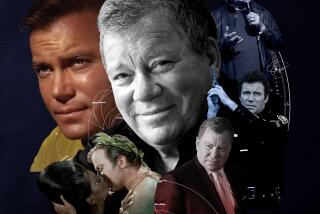A Performance Artist’s Flight of Fancy
- Share via
One recent sunny afternoon at the Odyssey Theatre, Kedric Robin Wolfe sat cross-legged inside a home-made steel cage on wheels. Would his visitor like to join him? Wolfe inquired politely. No? OK.
Tonight, the locally based performance artist opens at the Odyssey in “Flights of Fear and Fancy With Kedric Robin Wolfe,” an evening composed of two solo pieces, “There Was a Horse” and “Let Me Explain.”
“Explain” (which was conceived during a three-day fast) “is about a guy who falls in love, is rejected, goes nuts, gets into a really bad place inside his head, snaps out of it, the tables turn--and the whole thing reverses itself. A lot of the piece is done outside the cage, on the cage, around the cage. Occasionally he gets back in it, then comes out and goes back in. It’s a prison from which he can come and go. But he doesn’t have the key all the time--the key to his despair. He uses that key to unlock the door and gain liberation, before he goes back in again. It’s a lot like life.”
In contrast, “Horse” deals with death and is inspired by last year’s PSA crash, when an ex-employee took revenge on his boss, shooting the flight crew and downing the plane--with 43 people aboard.
“It was a horror story,” Wolfe sighed. “But the idea kept incubating in my mind. Then I’d have these arguments with myself: ‘It’s a terrible thing to be writing about. We’re saturated with it (in real life). Why bring it into the theater?’ But at the same time, I’d be taking notes, saying: ‘Well, if I were going to write about it, I’d make an outline that would look something like this--but I’m not really writing about it ‘cause I don’t like the subject. But if I were. . . .’ ”
In the midst of that internal repartee, Wolfe recalled the time when he working as a technical writer for an electronics company in Culver City. He’d found out that the older man who sat next to him had been in the German army on the Soviet front, and had been wounded there. “I was really curious,” Wolfe noted. “You don’t get to talk to someone who’s had that experience very often. So one day, I said: ‘Hey Conrad, tell me what it was like when you got shot.’ ”
Now, 15 years later, Wolfe resurrected that story, gathered up his research on the crash (including the names of the victims and data on the plane itself) and combined the two. “So the people are in the airplane, the guy makes his move with the gun, they’re on their way down . . . then suddenly, Conrad’s little story comes through. So we segue to the Russian front in World War II, and I quote him about the horse he’d seen on his way to the evacuation train. I finish that story, his observations about life in California--then we go back to the plane and finish the dive.”
Since his 6-year-old collaboration with Pipeline artistic director Scott Kelman, Wolfe’s eclectic mix of self-observation/revelation and theatrical storytelling has come to the stage in “Black,” “Ah, Kedric” (which included “Blind Stab” and “Face Up”) and “Warren’s Story.”
“In ‘Warren’s Story,’ I tell this story about getting caught passing this impassioned letter to a girl in the third grade,” he chuckled. “It took me days to write it. Then in school that day, I couldn’t find it; there was a hole in my pocket. I freaked out. I ran up the steps, and there was this great big teacher who pulled out the note and said: ‘Is this what you’re looking for? You should be ashamed of yourself for writing something so filthy .’ ”
Wolfe smiled. “I haven’t been hating that teacher for years. The experience--it’s gone. But when I was writing ‘Warren’s Story,’ all at once,” he clapped his hands, “it was there. Instantly available. And I said to myself, ‘That’s why I had that experience.’ And I remedied it by being able to put it in the piece. So that subconscious stuff comes up all the time. ‘Warren’s Story’ was a very autobiographical piece, though it’s really an exaggeration. All of it came from my personal experience--real or imaginary. It’s either my reality or my fantasy.”
The reality, he admits, has included lean times. Wolfe, who grew up on an isolated farm in Canton, Ohio (no other kids for miles, “but lots of cows, pigs and chickens”), half-jokes that “I’ve never made a living. For a time I did a number of TV commercials and lived on that, an occasional picture, something on television. It hasn’t been easy. But last year, I got a California Arts Council grant--thank you, California Arts Council--which was great. So I have not yet been allowed to starve to death.”
More to Read
The biggest entertainment stories
Get our big stories about Hollywood, film, television, music, arts, culture and more right in your inbox as soon as they publish.
You may occasionally receive promotional content from the Los Angeles Times.










